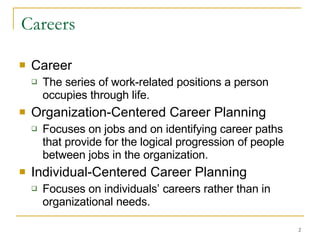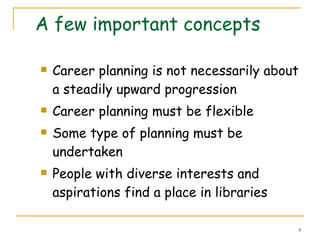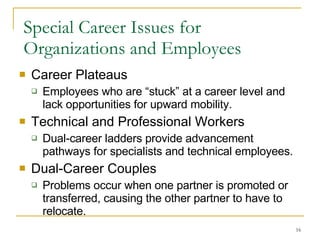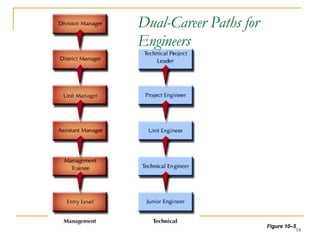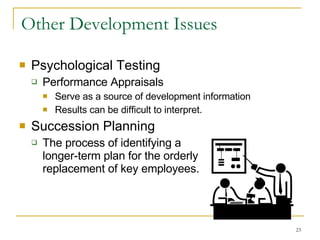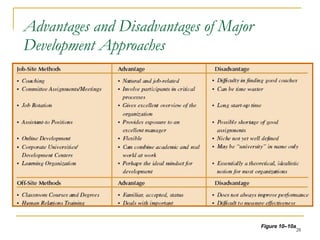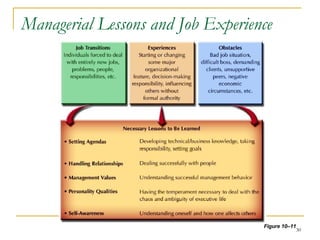Career Planning & Development For Employees.
- 1. Career planning & development for employees. By:Abhishek P Das PGM 07060481 MBA IT June 2007
- 2. Careers Career The series of work-related positions a person occupies through life. Organization-Centered Career Planning Focuses on jobs and on identifying career paths that provide for the logical progression of people between jobs in the organization. Individual-Centered Career Planning Focuses on individuals’ careers rather than in organizational needs.
- 3. We need to ask ourself.. “ In each of us rests the power to shape our future and it will be shaped by our action – or inaction” What inspired you to enter the profession? If you want a career in this profession, you need to plan, and work towards that plan
- 4. A few important concepts Career planning is not necessarily about a steadily upward progression Career planning must be flexible Some type of planning must be undertaken People with diverse interests and aspirations find a place in libraries
- 5. Professional Opportunities “ manage your own career, or let change manage it for you” Opportunities exist for new career paths for information professionals Develop a network of professional contacts, including mentors Become a member of professional committees
- 6. Taking Risks Initiate career changes Career development is not necessarily about a steadily upward trend Think outside the realm of traditional positions In today’s job market, there is more movement between jobs Portfolio careers – successive, frequent changes
- 7. Responsibility for one’s own career Be clear about what you want out of life Spend time on self-analysis and self-reflection Know your skills, abilities, values, aspirations, wants, needs, dreams and personal style .
- 8. Continuing Education & Professional Development Professional development can meet a number of needs: It may lead to a new career opportunity An injection of motivation and enthusiasm The pace at which mid-career stagnation takes place is accelerating An employee can reach a career plateau in as little as two years
- 9. For a successful career… Take the time to reflect Review the changing information landscape Think about possible directions to take Be creative, bold and visionary Grasp the opportunities presented
- 10. Organizational and Individual Career Planning Perspectives Figure 10 –1
- 11. Career Management for Individuals Setting Career Goals Self-Assessment Feedback on Reality Career Management
- 12. How People Choose Careers Career Choice Social Background Interests Self-Image Personality
- 13. Length of Time Employees Stay With Employers Figure 10 –2 Source: U.S. Department of Labor, Bureau of Statistics, 2001
- 14. General Career Periods Figure 10 –3
- 15. Late Career/Retirement Territoriality Self- Management Need to Belong Pride in Achievement Retirement Adjustment Goals
- 16. Special Career Issues for Organizations and Employees Career Plateaus Employees who are “stuck” at a career level and lack opportunities for upward mobility. Technical and Professional Workers Dual-career ladders provide advancement pathways for specialists and technical employees. Dual-Career Couples Problems occur when one partner is promoted or transferred, causing the other partner to have to relocate.
- 17. The “Portable” Career Path Figure 10 –4
- 18. Dual-Career Paths for Engineers Figure 10 –5
- 19. Developing Human Resources Development Efforts to improve employees’ ability to handle a variety of a variety of assignments. Developing Needs Analyses Assessment Centers A collection of instruments and exercises designed to diagnose individuals’ development needs. Intent is to identify management potential in participants.
- 20. Development vs. Training Figure 10 –6
- 21. The HR Development Process in an Organization Figure 10 –7
- 22. The HR Development Process HR Development Re-Development Make or Buy? Developing Specific Capabilities Lifelong Learning
- 23. Other Development Issues Psychological Testing Performance Appraisals Serve as a source of development information Results can be difficult to interpret. Succession Planning The process of identifying a longer-term plan for the orderly replacement of key employees.
- 24. Succession Planning Process Figure 10 –8
- 25. Choosing a Development Approach Job-Site Methods Committee Assignment/ Meetings Job Rotation “ Assistant to” Positions On-line Development Corporate Universities Career Development Learning Organization Individual Coaching
- 26. Possible Means Used in a Learning Organization Figure 10 –9
- 27. Choosing a Development Approach (cont’d) Sabbaticals and Leaves of Absence Classroom Courses and Degrees Human Relations Training Off-Site Methods Outdoor Training Simulations (Business Games)
- 28. Advantages and Disadvantages of Major Development Approaches Figure 10 –10a
- 29. Advantages and Disadvantages of Major Development Approaches Figure 10 –10b
- 30. Managerial Lessons and Job Experience Figure 10 –11
- 31. Management Development Managerial Modeling Management Coaching Mentoring Executive Education

